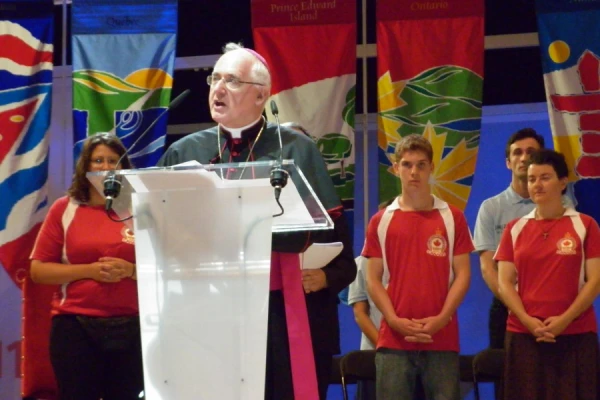
Vatican City, Dec 4, 2020 / 05:30 am (CNA).- Pope Francis accepted Friday the resignation of 76-year-old Canadian Archbishop Terrence Prendergast, S.J.
The pope confirmed Dec. 4 that Archbishop Marcel Damphousse, 57, would succeed Prendergast as archbishop of Ottawa-Cornwall, an archdiocese in Ontario formed in May this year.
Prendergast submitted his resignation in 2019, when he turned 75. Pope Francis accepted his retirement notice “nunc pro tunc” (now but to take effect later), allowing him to celebrate the 25th anniversary of his episcopal ordination at a Mass on Dec. 3.
“I am honored to have served as leader of the Archdioceses of Ottawa and Ottawa-Cornwall for 13 years,” Prendergast said, according to the website of his archdiocese.
“This large and generous community of faithful Catholics will continue to encourage me in my faith journey.”
Prendergast, a native of Montreal, was born on Feb. 19, 1944. He began his Jesuit novitiate in 1961 and was ordained to the priesthood in 1972.
From 1992 to 1994, he served as executive secretary of the Vatican’s Apostolic Visitation of Canadian seminaries (English sector).
In 1995, Pope John Paul II appointed him as an auxiliary bishop of Toronto.
He was named archbishop of Halifax, Nova Scotia, in 1998. Four years later, he was also appointed as apostolic administrator of the Diocese of Yarmouth.
Pope Benedict XVI chose Prendergast as archbishop of Ottawa in 2007. The archbishop also served as the Canadian member of Vox Clara, a committee advising the Vatican Congregation for Divine Worship of the English translation of liturgical texts.
In 2016, Prendergast was also asked to serve as apostolic administrator of the Diocese of Alexandria-Cornwall in Ontario. Pope Francis formally merged Prendergast’s two dioceses on May 6, 2020, forming the archdiocese of Ottawa-Cornwall, which covers 2,247 square miles and is based in the Canadian capital.
As recently as last Sunday, the pope entrusted Prendergast with new responsibilities, appointing him apostolic administrator of the troubled diocese of Hearst-Moosonee in Northern Ontario.
Damphousse, Prendergast’s successor, will now take on that role, as well as the leadership of Ottawa-Cornwall archdiocese.
He was born March 19, 1963, in Saint Joseph, Manitoba, and ordained a priest in 1991 for the Archdiocese of Saint Boniface.
Benedict XVI named him bishop of Alexandria-Cornwall in 2012. Three years later, Pope Francis appointed him bishop of Sault Ste. Marie.
On May 6 this year, the pope announced that Damphousse would serve as coadjutor archbishop of Ottawa-Cornwall, alongside Prendergast.
Damphousse’s inaugural Mass will take place on Dec. 8, the Solemnity of the Immaculate Conception. The Mass will be livestreamed due to coronavirus restrictions.
A tribute to Prendergast on the Ottawa-Cornwall archdiocese’s website said: “Archbishop Prendergast leaves a considerable legacy of accomplishments in the archdiocese. He is a staunch supporter of the pro-life movement, publicly opposing euthanasia and defending the life of the unborn.”
“He has made the Church present to people at public events, greeting parishioners after every Mass and appearing at conferences locally and across the country. He encouraged Communion and Liberation to institute the Way of the Cross on Good Friday in the streets of Ottawa, as they had in Halifax.”
“He was a columnist in the Catholic Register, the Ottawa Citizen, and the Ottawa Sun. He pioneered social media — blogging, Facebook, Twitter and Instagram and has appeared on YouTube — to reach a new generation.”
If you value the news and views Catholic World Report provides, please consider donating to support our efforts. Your contribution will help us continue to make CWR available to all readers worldwide for free, without a subscription. Thank you for your generosity!
Click here for more information on donating to CWR. Click here to sign up for our newsletter.





Leave a Reply